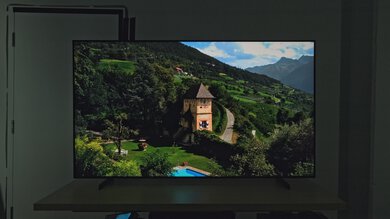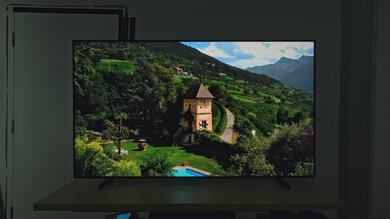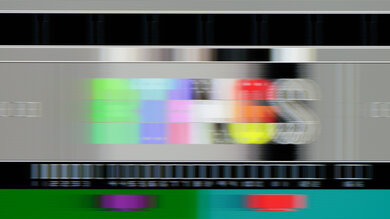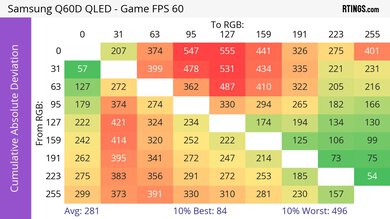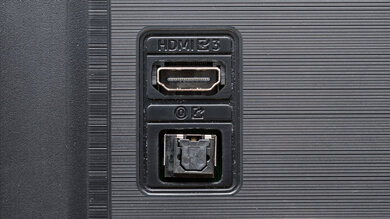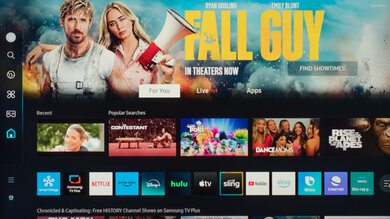The Samsung Q60D QLED is the lowest-end model in Samsung's QLED lineup. It replaces the Samsung Q60C QLED and sits below the Samsung Q70D QLED. Like its predecessor, it's a 60Hz TV and doesn't have modern features like HDMI 2.1 bandwidth, VRR support, or local dimming. It still has some basic features like Motion Xcelerator to help smooth out motion, and it supports Samsung's Multi View feature that allows for two sources to be displayed on the screen at the same time. The TV has a built-in 20W 2.0 channel speaker system and runs the 2024 version of Samsung's Tizen OS. It's available in eight different sizes: anything from a very small 32-inch to a huge 85-inch model.
Our Verdict
The Samsung Q60D is middling for mixed usage. It doesn't really have any strengths, as it's mediocre, at best, in most things it does. It's bright enough in SDR, with passable color volume, to look fine in well-lit rooms, such as when watching sports. Unfortunately, reflections still end up being distracting due to the TV's sub-par reflection handling. Its black levels are poor due to the lack of a local dimming feature, and it looks dim in HDR, so home theater purists won't be satisfied, even if its slow response time does lead to a very good stutter performance. The TV is not responsive enough for a good gaming experience, especially as it's limited to 60Hz and lacks VRR. Its image processing is mediocre, but it does upscale SD content quite well, so it's not a bad choice to pair with your old DVDs. It's not so good to pair with online streaming services, however, as its low-quality content smoothing is poor, so there's noticeable artifacting left in the feed.
Bright enough in SDR for use in a well-lit room.
Upscales SD content quite well.
No local dimming to improve black levels.
- Poor low-quality content smoothing with noticeable artifacts present.
Low peak brightness plus inaccurate and unremarkable colors in HDR.
- Slow response time leads to blurry motion.
Sub-par direct reflections handling leads to distracting glare in bright rooms.
The Samsung Q60D is sub-par for home theater use. Its biggest strength is its low amount of stutter, due to the TV's slow response time. Aside from that, it doesn't really impress visually. Its black levels are poor due to the lack of a local dimming feature, so most scenes look washed out, even with its impressive black uniformity. The TV is dim in HDR, so highlights don't pop, which, combined with the TV's poor black levels, leads to an underwhelming viewing experience. Its color volume is passable, but it's not accurate in HDR, so purists won't be satisfied. It has poor low-quality content smoothing, so low-bitrate streams have noticeable artifacts, although it does upscale SD content quite well, so your DVDs look clear enough. It removes judder from 24p sources, but it doesn't remove 24p judder from 60Hz sources like cable boxes. It also doesn't support Dolby Vision HDR or passthrough DTS audio formats.
Very good stutter performance.
Upscales SD content quite well.
Impressive black uniformity.
Doesn't remove 24p judder from 60Hz sources.
No local dimming to improve black levels.
- No Dolby Vision or DTS audio support.
- Poor low-quality content smoothing with noticeable artifacts present.
Low peak brightness plus inaccurate and unremarkable colors in HDR.
The Samsung Q60D delivers a mediocre bright-room viewing experience. It's bright enough in SDR for a well-lit room, but its direct reflection handling is sub-par, so reflections are distracting. Its color volume is passable in SDR, and its color accuracy is okay, enough to satisfy most people, even if it doesn't exactly look vibrant. The TV's darker colors do lose some color saturation in well-lit rooms, but as the TV's colors are so unremarkable to begin with, it's not very noticeable. Its black levels, however, barely go down in well-lit contexts, but, again, since they're poor to begin with, they still look raised and washed out in most content.
Bright enough in SDR for use in a well-lit room.
Sub-par direct reflections handling leads to distracting glare in bright rooms.
The Samsung Q60D is acceptable for watching sports, but it doesn't do anything special. It's bright enough in SDR to overcome some glare in a well-lit room, but the reflections are still distracting due to the TV's sub-par direct reflection handling. It's colorful enough in SDR so that your favorite teams' jerseys don't look washed out, but they won't pop out of the screen either. Its viewing angle is unremarkable; not a good choice for a wide seating arrangement, but it's acceptable enough for small groups. The TV's gray uniformity is adequate, but there's still some dirty screen effect when watching sports with large areas of uniform color. Unfortunately, the TV has a slow response time, so there's noticeable blur behind fast-moving players and objects.
Bright enough in SDR for use in a well-lit room.
Upscales SD content quite well.
- Narrow viewing angle leads to a degraded image when viewed from the sides.
- Poor low-quality content smoothing with noticeable artifacts present.
- Slow response time leads to blurry motion.
Sub-par direct reflections handling leads to distracting glare in bright rooms.
The Samsung Q60D is middling for gaming. It has low input lag at 60Hz, but it doesn't support 120Hz and above, and it doesn't support VRR, limiting its appeal for gamers seeking a more responsive gaming experience. Its pixel transitions are also relatively slow across the board, leading to a blurry gaming experience. Visually, it doesn't impress, as the TV is dim in HDR, and its black levels are poor. Its color performance is mediocre overall; it won't bother most people shopping at this price point, but it also won't give you a vibrant gaming experience.
Low input lag at 60Hz.
Impressive black uniformity.
- No VRR support and is limited to 60Hz.
No local dimming to improve black levels.
Low peak brightness plus inaccurate and unremarkable colors in HDR.
- Slow response time leads to blurry motion.
The Samsung Q60D's brightness performance is middling. Its SDR brightness is okay, but the TV is dim in HDR, so highlights don't pop, leading to a lackluster HDR viewing experience.
Bright enough in SDR for use in a well-lit room.
Low peak brightness plus inaccurate and unremarkable colors in HDR.
The Samsung Q60D's black level is poor. This is mostly due to its lack of local dimming, which leads to poor contrast as the entire screen looks blueish and washed out in darker scenes. However, the TV has great black uniformity, which is particularly impressive for a TV without local dimming, as there's limited blooming around bright highlights set against a black or very dark background.
Impressive black uniformity.
No local dimming to improve black levels.
Low peak brightness plus inaccurate and unremarkable colors in HDR.
The Samsung Q60D has mediocre color performance overall. Its color volume is passable in HDR and SDR; colorful enough for most people, but it won't impress your friends. Its color accuracy in SDR is okay, so purists won't be satisfied, but everyone else will. Unfortunately, its color accuracy in HDR is inadequate, meaning that HDR content often looks off.
Low peak brightness plus inaccurate and unremarkable colors in HDR.
Note: We're in the process of improving our tests related to image processing, but this score should give you a general idea of how a TV performs overall with its image processing capabilities.
The Samsung Q60D has mediocre image processing overall, as it struggles with cleaning up low-bitrate content, so most of that content looks blocky. Its PQ EOTF tracking is passable, so it doesn't fully respect the content creator's intent when it comes to HDR brightness, but it won't bother most people. There's also some visible banding in HDR gradients, but it's not excessive. It does, however, upscale SD content quite well, so your low-resolution content looks relatively clean.
Upscales SD content quite well.
- Poor low-quality content smoothing with noticeable artifacts present.
The Samsung Q60D's responsiveness in Game Mode is sub-par. Because it doesn't support VRR, there's some noticeable screen tearing. Although its input lag at 60Hz is low enough for a reasonably responsive feel, the TV doesn't support 120Hz or higher refresh rates, limiting its appeal to gamers seeking a more responsive experience. Moreover, its slower pixel transitions lead to noticeable motion blur.
Low input lag at 60Hz.
- No VRR support and is limited to 60Hz.
- Slow response time leads to blurry motion.
We're in the process of fixing the way we evaluate a TV's overall motion handling. This section is currently broken, and the score isn't indicative of how well a TV handles motion overall.
Performance Usages
Changelog
-
Updated Oct 31, 2025:
We bought and tested the Samsung Q8F 2025, and added a comparison in the HDR Brightness section.
- Updated May 08, 2025: Converted to Test Bench 2.0.1. We did this to fix an issue with our scoring in the Supported Resolutions section, since TVs with a refresh rate higher than 144Hz were being penalized for not supporting 144Hz.
-
Updated Mar 26, 2025:
We wrote text for the new tests and rewrote text throughout the review after updating pre-existing tests and scores for Test Bench 2.0.
- Updated Mar 26, 2025: We converted the review to Test Bench 2.0. With this new methodology, we've added new tests to expand the scope of our testing, adjusted our scoring to better align with current market conditions, and added performance usages that group related tests together to give more insight into specific aspects of a TV's performance. You can find a full list of changes in the TV 2.0 changelog.
Check Price
Differences Between Sizes And Variants
We've bought and tested the 65-inch Samsung Q60D, which is also available in 32-inch, 43-inch, 50-inch, 55-inch, 70-inch, 75-inch, and 85-inch sizes. All sizes offer the same picture quality and overall performance.
Note that with Samsung TVs, the five letters after the short model code (AFXZA in this case) vary between different retailers and regions, but there's no difference in performance. The Samsung QE1D is a Samsung store online exclusive that performs the same, but it's only available in 70-inch, 75-inch, and 85-inch sizes. Costco and Sam's Club sell a variant of this TV known as the Samsung Q60DD. This variant performs the same but comes with an extended warranty and other store-specific perks.
| Size | US Model | Warehouse Model (US) |
|---|---|---|
| 32" | QN32Q60DAFXZA | - |
| 43" | QN43Q60DAFXZA | - |
| 50" | QN50Q60DAFXZA | - |
| 55" | QN55Q60DAFXZA | QN55Q60DDFXZA |
| 65" | QN65Q60DAFXZA | QN65Q60DDFXZA |
| 70" | QN70Q60DAFXZA | - |
| 75" | QN75Q60DAFXZA | QN75Q60DDFXZA |
| 85" | QN85Q60DAFXZA | QN85Q60DDFXZA |
Our unit was manufactured in February 2024.
Popular TV Comparisons
The Samsung Q60D is a very basic TV that is middling overall. It's substantially overpriced for a TV lacking modern features, and its picture quality is nothing special. You're better off buying the better and cheaper Hisense U6/U6N or TCL Q6/Q651G QLED, as they outperform the Samsung in most ways. If you're looking for the cheapest TV possible consider the Roku Select Series instead, even if the Samsung is generally a bit better, but for a higher price. If you want a TV loaded with modern features and with much better overall picture quality, check out the TCL QM7/QM751G QLED.
For more options, check out our recommendations for the best TVs under $1,000, the best 65-inch TVs, and the best TVs for gaming.
The Samsung Q60D and the Samsung Q8F 2025 perform differently, and the best one depends on what you care about. The Q8F offers better gaming features, with HDMI 2.1 bandwidth, a much higher refresh rate, and VRR support to reduce tearing. The Q60D, on the other hand, gets a bit brighter, so it can handle more glare in a bright room, and HDR content looks slightly better.
Both TVs aren't very good, but the Samsung Q60D is better than the Samsung Q7F 2025. The Q60D is noticeably brighter, so it overcomes more glare in a well-lit room, and colors are also more vibrant on it. Low-resolution content looks better on the Q60D thanks to its superior upscaling. On the other hand, the Q7F is more accurate out of the box.
The Samsung Q70D is better than the Samsung Q60D in most ways. The Q70D gets brighter in SDR, so it fights more glare in a well-lit room. The Q70D also gets brighter in HDR and has better PQ EOTF tracking, so it delivers a more impactful and accurate HDR experience. The Q70D is the better gaming TV, as it has HDMI 2.1 bandwidth, 4k @ 120Hz, and VRR; it pairs much better with modern consoles. However, the Q60D has better contrast, so its blacks are deeper in a dark room.
The Samsung Q80D is much better than the Samsung Q60D. The Q80D is far brighter and has a much better contrast due to its local dimming feature. It also has better color volume, better image processing, and is more accurate out of the box. Gamers will appreciate the Q80D's 120Hz support with VRR, while the Q60D is limited to 60Hz without VRR. The only advantage of the Q60D over the Q80D is its slightly wider viewing angle.

We buy and test dozens of TVs yearly, taking an objective, data-driven approach to deliver results you can trust. Our testing process is complex, with hundreds of individual tests that take over a week to complete. Most of our tests are done with specially designed test patterns that mimic real content, but we also use the same sources you have at home to ensure our results match the real-world experience. We use two main tools for our testing: a Colorimetry Research CR-100 colorimeter and a CR-250 spectroradiometer.
Test Results

The Samsung Q60 TV has inadequate HDR brightness. It gets bright enough for some dimmer highlights to stand out, but it's not enough for most highlights to pop. Combined with the TV's only okay contrast, it doesn't provide an impactful HDR experience, but it's a bit better than lower-end Samsung models like the Samsung Q8F 2025.
These measurements are after calibrating the HDR white point with the following settings:
- HDR Picture Mode: Filmmaker
- Brightness: 50
- Contrast: 50
- Color: 25
- HDR Tone Mapping: Static
- Color Tone: Warm 2
- Color Space: Auto
- Gamma: ST.2084 (0)
Results with HDR Tone Mapping set to 'Active':
- Hallway Lights: 383 cd/m²
- Yellow Skyscraper: 312 cd/m²
- Landscape Pool: 165 cd/m²
The Samsung Q60DD is slightly brighter in Game Mode, but it's less accurate.
These measurements are after calibrating the HDR white point with the following settings:
- HDR Picture Mode: Game
- Brightness: 50
- Contrast: 50
- Color: 25
- HDR Tone Mapping: Static
- Color Tone: Warm 2
- Color Space: Auto
- Gamma: ST.2084 (0)
- Game HDR: Basic
Results with HDR Tone Mapping set to 'Active':
- Hallway Lights: 389 cd/m²
- Yellow Skyscraper: 363 cd/m²
- Landscape Pool: 218 cd/m²
The Samsung Q60D has alright SDR brightness and is bright enough to overcome glare in a well-lit room.
These measurements are after calibration with the following settings:
- Picture Mode: Movie
- Brightness: 50
- Contrast: 45
- Color: 25
- Color Tone: Warm 2
- Gamma: 2.2
- Color Space: Custom
Unfortunately, when displaying a 2% window, the TV automatically adjusts the backlight and APL to enhance contrast, and there's no setting to disable this automatic adjustment.
This TV doesn't have a local dimming feature, so it can't adjust the backlight of individual zones to brighten up highlights without impacting the rest of the image. This means that there are no distracting flickers or brightness changes as bright highlights move between dimming zones.
The TV has passable SDR color volume, but barely. It lacks the color volume in DCI-P3 to fully display dark colors and even less with brighter ones. Still, it displays blues, magentas, and even some reds quite well. The TV's color volume is inadequate in the BT.2020 color space, however; here it struggles with fully displaying almost all colors, and its total coverage is about half of the total color space.
| Volume ΔE³ | DCI-P3 Coverage |
BT.2020 Coverage |
|---|---|---|
| L10 | 89.00% | 64.42% |
| L20 | 89.04% | 63.22% |
| L30 | 87.80% | 62.18% |
| L40 | 85.11% | 61.25% |
| L50 | 82.43% | 60.05% |
| L60 | 76.67% | 54.91% |
| L70 | 70.92% | 45.70% |
| L80 | 70.52% | 43.49% |
| L90 | 71.06% | 43.66% |
| L100 | 74.73% | 48.79% |
| Total | 77.21% | 52.25% |
The TV's color volume in HDR is passable. It doesn't display darker colors well due to its lack of local dimming, and its low peak brightness limits its ability to display bright and vibrant colors.
The TV has okay SDR pre-calibration accuracy. Blues and greens are underrepresented in darker shades of gray, reds are underrepresented in all grays, and greens are a bit overrepresented in brighter grays. The color temperature is noticeably cooler than our target of 6500K, and gamma is close to our target of 2.2, but dark scenes are too dark, and bright scenes are too bright. The TV has good color accuracy, but yellows, reds, and magentas are off the mark.
The Samsung Q60D has fantastic SDR accuracy after calibration. It's a bit tricky to calibrate and requires custom adjustments to be made to some colors, and it wasn't possible to fix anything below 30%. Nonetheless, the color temperature is much closer to our target of 6500K, and the color accuracy is outstanding, with only some small inaccuracies with reds and blues. White balance is almost perfect, but reds, blues, and greens are slightly underrepresented in dark shades of gray. Gamma is very close to our target of 2.2, but dark scenes are still too dark.
You can see our full calibration settings.
The Samsung Q60 has disappointing HDR accuracy before calibration. Reds are underrepresented, and greens are overrepresented in brighter grays. This gives the TV an extremely cold color temperature, giving everything an obvious blue tint. All colors are off-target, especially reds, blues, and greens, and there are significant color mapping issues in all colors except brighter grays.
After calibration, the TV has decent HDR accuracy. While the TV's white balance is noticeably improved, reds, blues, and greens are all very slightly overrepresented in all grays, and its color temperature is still far too cold. Color accuracy is vastly improved, however, with significantly fewer color mapping issues in all colors.
The TV has passable PQ EOTF tracking. Blacks are displayed brighter than intended, but afterward, all tones are slightly, but noticeably, darker than intended. There's a roll-off near the TV's peak brightness to maintain details in highlights. With content mastered at 4000 nits, the roll-off is even more gradual.
The TV has poor low-quality content smoothing. It does an outstanding job at preserving detail, but there's almost no smoothing actually done to the image, so there's still significant macro-blocking in dark scenes. If you need a TV that does a better job removing artifacts from low-quality content, check out the Sony BRAVIA 3.
The Samsung Q60D QLED TV does a good job at upscaling low-resolution content like DVDs or lower-resolution streams. Details are clear enough, but finer details are hard to make out.
Sharpness processing was calibrated with no over-sharpening for low-resolution content, with the following settings:
- Sharpness: 5
- Picture Clarity Settings: Off
The TV has mediocre HDR gradient handling. There's very apparent banding in greens and some noticeable banding in grays and blues. Reds fare better and have minimal banding.
This TV has low input lag at 60Hz when set to Game Mode, but it doesn't support 120Hz and above at any resolution, limiting its usability when it comes to responsive high refresh rate gaming.
The Samsung Q60D supports all common resolutions up to 4k @ 60Hz. It displays chroma 4:4:4 properly with any signal as long as the input label is set to PC, which is important for reading clear text from a PC. If you need a TV that supports 4k @ 120Hz, take a look at the Samsung Q70D QLED.
This TV doesn't support a variable refresh rate (VRR) to reduce screen tearing. If you want a budget TV with VRR, consider the Hisense QD7N QLED.
This Samsung Q60D doesn't support a 120Hz refresh rate.
The Samsung Q60D is a 60Hz TV, so it only supports 4k @ 60Hz on the P55. It has Auto Low Latency Mode (ALLM), so it'll automatically switch to Game Mode when the TV detects a game console as its input device, which gives you the lowest possible input lag for games. Unfortunately, 1440p doesn't work with the PS5 and this TV.
The Samsung Q60D is a 60Hz TV, so it only supports 4k @ 60Hz on the Xbox Series X|S. It has Auto Low Latency Mode, so it'll automatically switch to Game Mode when the TV detects a game console as its input device, which gives you the lowest possible input lag for games. Unfortunately, when the Xbox is set to 1440p, you're locked out of ALLM and HDR.
Due to the TV's slow response time, there's very little noticeable stutter when watching 24p content.
The TV gives a judder-free experience with 24p sources like a Blu-ray player and native apps. Unfortunately, it doesn't remove 24p judder from 60Hz sources like most cable TV boxes and older streaming devices that lack a Match Frame Rate feature.
The Samsung Q60D Series has an inadequate response time. Most motion is blurry, and many transitions in dark scenes are slow, which results in black smearing behind dark objects. If you want a TV with a faster response time, check out the Hisense U6/U6N.
The TV uses pulse-width modulation (PWM) to dim its backlight, which introduces flicker that can bother people who are sensitive to it. The amount of flicker varies depending on what picture mode the TV is set to and what settings you're using.
It flickers at 480Hz in the 'Movie' Picture Mode at all brightness levels, but all other picture modes, including Game Mode, flicker at a much slower 120Hz, which can cause image duplications or headaches if you're sensitive to flicker. When using the 'Picture Clarity' setting, the TV flickers at 120Hz. With 'LED Clear Motion' enabled, the TV only flickers at 60Hz.
The TV supports backlight strobing, more commonly known as black frame insertion (BFI). The feature is designed to improve the appearance of motion by strobing its backlight and reducing the amount of persistence blur.
This TV has an optional motion interpolation feature to improve the clarity of motion, but it doesn't work very well. Even slower-moving scenes have some noticeable artifacts and haloing present. In faster-moving scenes, it can't keep up, and there are distracting artifacts and haloing, and sometimes the TV stops interpolating altogether.
The TV's direct reflection handling is sub-par. While it does reduce the intensity of direct reflections to a small degree, they're still very obvious, leading to an unpleasant viewing experience when you have bright lights or windows shining directly on the TV.
The TV does a fantastic job retaining its black levels in a bright room. Blacks are barely raised as more light is added to your room, so you get very similar black levels regardless of your lighting. That said, it has poor black levels to begin with, so you never see deep blacks on this model.
The TV has okay color saturation when used in a well-lit room. Overall, there's barely any difference in the vibrancy of colors, whether you're in a dark room or a bright one, although darker colors look slightly more washed out. Still, it has somewhat limited color volume to begin with, so colors lack vibrancy regardless of your lighting conditions.
The TV's viewing angle is unremarkable, so it's not suitable for a wide seating arrangement. As you move off-center, there's significant gamma shifting, color shifting, and brightness loss, and colors look increasingly washed out as you move further away to the sides.
The Samsung Q60D has adequate gray uniformity. The sides of the screen are darker than the middle, and there's some noticeable dirty screen effect towards the center of the screen. On a very dark or near-black screen, its uniformity is excellent, but the corners and the bottom edge are a bit brighter than the rest of the screen.
The TV uses a BGR (Blue-Green-Red) subpixel layout instead of the traditional RGB layout. For video or gaming content, this doesn't cause any issues, but for PC monitor use, it can be a problem as it impacts the text clarity, although not everyone will notice this.
The TV has decent separation between colors, which helps somewhat with its color purity and its ability to display a satisfactory range of colors, although they don't look vibrant.
The TV has eARC support, which allows it to pass uncompressed high-quality audio from a connected source to your home theater system or soundbar. Unfortunately, it doesn't support any DTS formats commonly used on Blu-rays.
7.1 channel LPCM only works with sources that allow you to manually override the EDID, like a PC. If you can't override the EDID, it's limited to 5.1.
Unfortunately, Samsung still doesn't support Dolby Vision. However, it supports HDR10+ instead, which is similar overall but not as widely supported.
The TV uses two plastic feet that support the TV well. The footprint of the 65-inch stand is 42.2" x 10.8".
The height of the feet is adjustable, and you can set them to two different positions. The lower position, which you can see in the photo, puts the screen close to the table. The other position is high enough that most soundbars fit below the screen. The height of the lower position from the table is 1.97", and the higher one is 2.95".
The back of the TV is made of plastic and has a nice brushed finish. There's a single clip included that can be attached to either foot and used for cable management. Unfortunately, the inputs are recessed into the TV, so they're hard to reach if you wall-mount it with a fixed bracket.
The Samsung Q60 Series has decent build quality. The stand supports the TV well in the lower position, but there's some wobble front to back in the higher position, although this won't cause any issues. There are no major flaws with build quality, but the TV feels cheap since it's made entirely of plastic.
The TV comes with the 2024 version of Samsung's proprietary Tizen OS but has a reduced feature set compared to more expensive models, so you don't get features like TV to Mobile or Ambient Mode+. Still, it's fast and easy to use and supports Samsung's popular Multi View feature.
The Samsung Q60D comes with the same minimalistic remote as the 2023 Samsung Q60C QLED. The remote has a rechargeable battery that can be charged via USB-C or solar power. It has buttons for popular streaming services, and the voice control gives you access to Bixby and Alexa. You can ask it to change settings, switch inputs, and answer basic questions, but it can't search for content within apps.
The TV's frequency response is mediocre. Like most TVs, bass is pretty much non-existent. The sound is well-balanced at moderate listening levels, so the dialogue is clear, but it sounds progressively worse as the volume increases. Since the TV doesn't get very loud, it's best suited for a quiet environment.



